On this article, we’ll introduce .NET Blazor, a strong framework that unifies client-side and server-side growth paradigms and presents enhanced efficiency and improved tooling.
Introducing .NET Blazor
One of many principal challenges builders face usually is that they should know two completely different languages — one for the server-side growth, and one for the client-side growth. .NET Blazor tries to bridge the hole between client-side and server-side growth by enabling builders to construct interactive net functions utilizing C# and .NET. So builders can depend on a single growth language framework and reuse the expertise and data they have already got.
This difficulty was the principle cause behind Microsoft’s .NET Blazor framework. It really began as a private side-project of Steven Sanderson, Principal Software program Engineering Lead at Microsoft in 2017, which advanced into server-side Blazor mid 2019, and client-side (WebAssembly) in 2020.
On this article, we’ll begin from the latest historical past of net app growth, and the principle variations between server-side and client-side net app architectures. From there, we’ll map each architectures with present corresponding Blazor internet hosting fashions. Within the second a part of the article, we’ll be taught in regards to the upcoming modifications within the subsequent Blazor launch based mostly on .NET 8 later in 2023, and easy methods to develop our first Blazor app utilizing the present .NET 8 preview 7.
The Current Historical past of Net App Growth
The world of net app growth will be summarized in server-side and client-side architectures.
Server-side, because the identify implies, requires an underlying net server, corresponding to Home windows Web Info Server (IIS), Linux Apache, or NGINX, or a containerized platform model of the identical.
Server-side growth depends on producing HTML on the server and sending it to the consumer. Applied sciences like ASP.NET Net Varieties present wealthy controls and abstractions, making it simpler to construct complicated net functions. Nonetheless, the tight coupling between server and consumer usually results in challenges in sustaining scalability and responsiveness. If the consumer can’t attain the server, there’s no net web page (or a web page saying HTTP 404 error). Varied languages are used for the precise net software growth, corresponding to C# .NET, Java, and PHP.
Shopper-side refers to an internet software situation, which doesn’t require a server within the backend, however slightly runs fully within the browser.
The evolution of net app growth started with static HTML pages. Because the demand for dynamic content material and interactivity grew, applied sciences like JavaScript emerged, enabling builders to construct extra interactive net functions. The early 2000s witnessed the rise of AJAX (Asynchronous JavaScript and XML), which allowed for asynchronous information trade between the consumer and the server, leading to smoother consumer experiences. Frameworks like jQuery additional simplified client-side scripting. Twenty years later, the web sites we’re visiting every day are nonetheless based totally on HTML and JavaScript.
Blazor Internet hosting Fashions
.NET Blazor presents two principal internet hosting fashions: Blazor Server and Blazor WebAssembly.
Blazor Server permits builders to create wealthy and dynamic net functions, the place the consumer interface logic is 100% executed on the server, and the UI updates get despatched to the consumer over a persistent SignalR connection. This mannequin supplies real-time interactivity whereas sustaining a well-recognized programming mannequin for .NET builders. It’s nicely suited to functions that require dynamic updates corresponding to pulling up database info in a retail/eshop situation, buyer profiles, monetary inventory reporting and the like, in addition to sometimes having a decrease latency tolerance.
The picture beneath presents a diagram of Blazor server structure.
Let’s take a look at a few of the execs and cons of server-side Blazor.
Professionals:
- Quick load time, assuming the online server is sized accurately.
- Closest to conventional ASP.NET Core growth.
- Assist for older browsers, as no requirement for WebAssembly (though this might be seen as a adverse level from a safety and supportability perspective).
Cons:
- Shopper/Browser consumes extra reminiscence to run the online app, and is 100% depending on the SignalR connection.
- Every consumer session consumes CPU and reminiscence on the server, which could herald right-size challenges for functions below heavy or spike load.
- Shopper Server communication assumes a “robust” connection to keep away from latency and errors.
Blazor WebAssembly takes a completely completely different method, permitting builders to run .NET code instantly within the browser utilizing WebAssembly (aka Wasm), a binary instruction format for net functions. This mannequin permits Blazor to run the execution of C# code on the consumer aspect, lowering the necessity for fixed communication with the server. Blazor WebAssembly is good for situations the place functions should be totally client-side, but nonetheless offering a wealthy and responsive consumer expertise — much like what customers sometimes count on from server functions.
The picture beneath presents a diagram of Blazor WebAssembly structure.
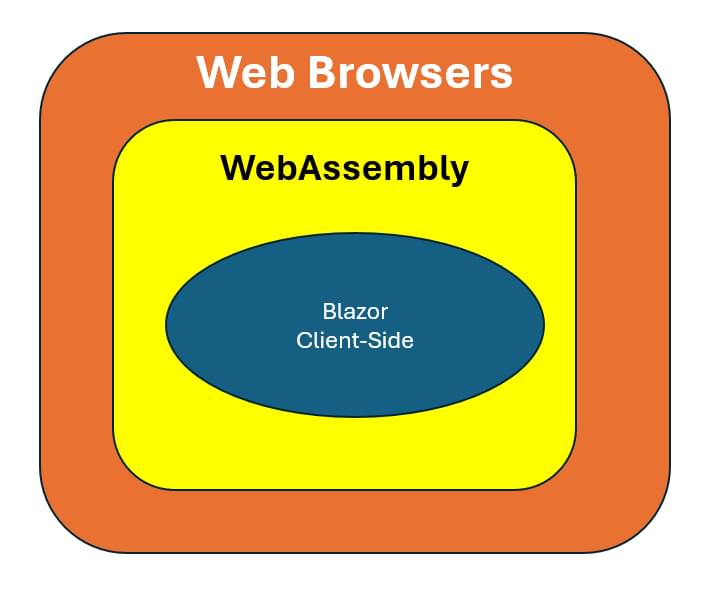
Let’s take a look at a few of the execs and cons of WebAssembly.
Professionals:
- An internet site will be deployed as static recordsdata, because it all runs within the browser.
- Wasm Apps can run offline, as there is no such thing as a want for server connection (on a regular basis).
- Assist for progressive net apps (PWAs), which suggests it may well act as a regionally put in software on the consumer machine.
Cons:
- Because the JavaScript engine within the browser must obtain the total Blazor app and corresponding .NET DLLs, the primary load of the app might be thought of comparatively sluggish.
- WebAssembly requires a contemporary browser. If previous browsers are nonetheless in use and required, you possibly can solely use Blazor Server.
- If put in as a PWA, there’s a problem round model updates and administration.
- Code and DLLs will be decrypted. Any secrets and techniques corresponding to connection strings, passwords and the like shouldn’t be used throughout the code, as they’re seen within the browser dev instruments.
Observe: Blazor has two different internet hosting fashions — Hybrid, which targets desktops and cellular platforms, and Cellular Blazor Bindings, which is experimental and aiming for multi-platform situations corresponding to iOS and Android, moreover Home windows and macOS.
Irrespective of the runtime model, Blazor apps are created utilizing Razor Parts, generally also referred to as Blazor Parts or simply elements. Every element is a stand-alone piece of a UI-element, sometimes shaped by a mix of HTML code for the web page format, and a snippet of C# code for the logic and dynamic content material.
The code beneath reveals a pattern Blazor element, with a counter subject and a button within the @web page(HTML) part, the place the logic is within the @code part:
@web page "/counter"
<h1>Counter</h1>
<p>Present rely: @currentCount</p>
<button class="btn btn-primary" @onclick="IncrementCount">Click on me</button>
@code {
non-public int currentCount = 0;
non-public void IncrementCount()
{
currentCount++;
}
}
The way forward for Blazor with .NET 8
In November 2023, Microsoft will launch the .NET 8 framework, which is at the moment in preview v7 (see the .Web group’s bulletins right here).
Particularly for Blazor, the next modifications are on the present roadmap.
Server-side Rendering
Server-side rendering follows the present logic of Razor pages or MVC Purposes, much like ASP.NET Net Varieties beforehand. Razor Pages is a page-based mannequin. UI and enterprise logic issues are saved separate, however throughout the web page.
Razor Pages is the beneficial approach to create new page-based or form-based apps for builders new to ASP.NET Core. It supplies a neater start line than ASP.NET Core MVC. ASP.NET MVC renders UI on the server and makes use of a model-view-controller (MVC) architectural sample.
The MVC sample separates an app into three principal teams of elements: fashions, views, and controllers. Consumer requests are routed to a controller. The controller is chargeable for working with the mannequin to carry out consumer actions or retrieve outcomes of queries. The controller chooses the view to show to the consumer, and supplies it with any mannequin information it requires. Assist for Razor Pages is constructed on ASP.NET Core MVC.
Because of server-side rendering (SSR), the server generates the HTML code in response to a request from the browser/consumer. The large profit with SSR is that efficiency will dramatically improve, as there’s no WebAssembly object to be downloaded when loading the app. In contrast with utilizing Razor pages or MVC — which technically does the identical as what we defined within the earlier sentence — builders can profit from Blazor’s component-based structure, which doesn’t actually exist with Razor or MVC. Whereas the component-based method would possibly really feel completely different at first, as soon as we get the cling of it, we see that numerous code duplication from the previous can now be moved right into a reusable Blazor element. Consider buttons, banners, types, tables,and so forth — the place the item stays however the information content material modifications.
4 fashions in a single
4 fashions in a single looks like the final word growth answer. The present fashions (server-side, Wasm, hybrid and cellular bindings) are mixed with .NET 8 right into a single method, irrespective of the situation. Because of Blazor, it’s attainable to develop wealthy server-based functions, and client-only apps with Wasm, in addition to cross-platform iOS, Android and macOS apps — all based mostly on the identical Blazor framework.
Streaming rendering
Streaming rendering is one other promising functionality in .NET 8 Blazor, which is the center floor between server-side and client-side rendering. Do not forget that, with server-side, the total HTML web page is rendered by the server. Streaming rendering permits the rendering of the static HTML, in addition to placeholders for content material. As soon as the async server-side name is full — which means it may well stream the information — the precise HTML web page is up to date by filling within the placeholder objects with the precise information.
Server Aspect and WebAssembly
Server Aspect and WebAssembly will nonetheless be accessible in the identical manner they work with the present model of Blazor, however they’ll be extra optimized.
Auto mode
Auto mode is the one I’m personally having most expectations of, and representing the “final” Blazor situation, permitting a mix of each server-side and WebAssembly in a single.
This situation presents the preliminary web page from the server, which suggests it is going to load quick. Subsequently, the mandatory objects are downloaded to the consumer, so the following time the web page masses, it’s provided from Wasm. (This model isn’t current within the .NET 8 preview 7 but, so there aren’t extra particulars to share on the time of penning this.) If you happen to assume that is fairly much like the “4 fashions in a single” method described earlier, know that auto mode is focusing on browser apps, not full desktop or cellular platform situations.
Constructing Our First Blazor .NET 8 Net App
Now we’ve got a a lot better understanding of what Blazor is all about, and what’s getting ready for the following launch of .NET 8, let’s stroll by way of a hands-on situation, the place we’ll create our first .NET 8 Blazor app.
Conditions
To make this as platform unbiased as attainable, the belief is you may have a machine with the next elements:
- Obtain .NET 8 Preview 7 from right here and set up it in your growth workstation.
- Obtain Visible Studio Code from right here and set up it in your growth workstation.
- Create a subfolder named
Blazor8sample. This folder will host the .NET software.
Constructing the app
With the conditions out of the way in which, let’s stroll by way of the following steps: creating an app utilizing the Blazor template, and operating it on our growth workstation.
-
Open a terminal window, and browse to the
Blazor8samplefolder created earlier. -
Run the next command to validate the .NET model:
dotnet --version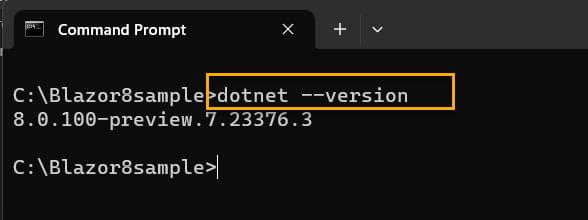
-
Run the next command to get the small print for the brand new Blazor template:
dotnet new Blazor /?
-
Run the next command to create the brand new Blazor App:
dotnet new Blazor -o Blazor8SampleApp
-
Navigate to the subfolder
Blazor8SampleApp, and runcode .to open the folder in Visible Studio Code.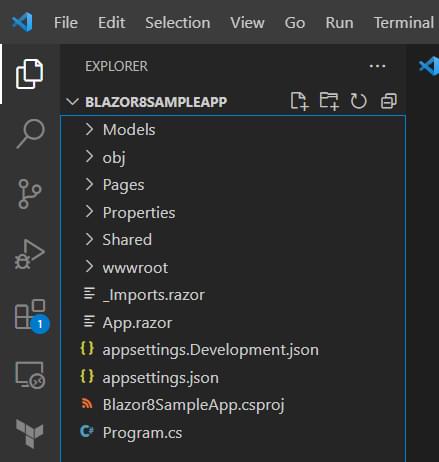
-
From inside Visible Studio Code, navigate to Terminal within the high menu, and choose New Terminal (or use Ctrl + Shift + ` shortcut keys on Home windows). This opens a brand new Terminal window inside VS Code.
-
Within the Terminal window, run the next command to launch the Blazor App:
dotnet run .Blazor8SampleApp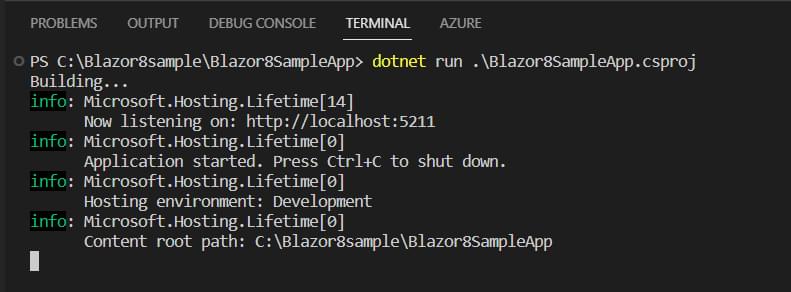
-
Navigate to the localhost listening URL (corresponding to
http://localhost:5211in my instance). Observe: the port is likely to be completely different in your machine, so test the URL for the precise port quantity.This opens the operating Blazor Net App in your default browser. Open the Climate web page.
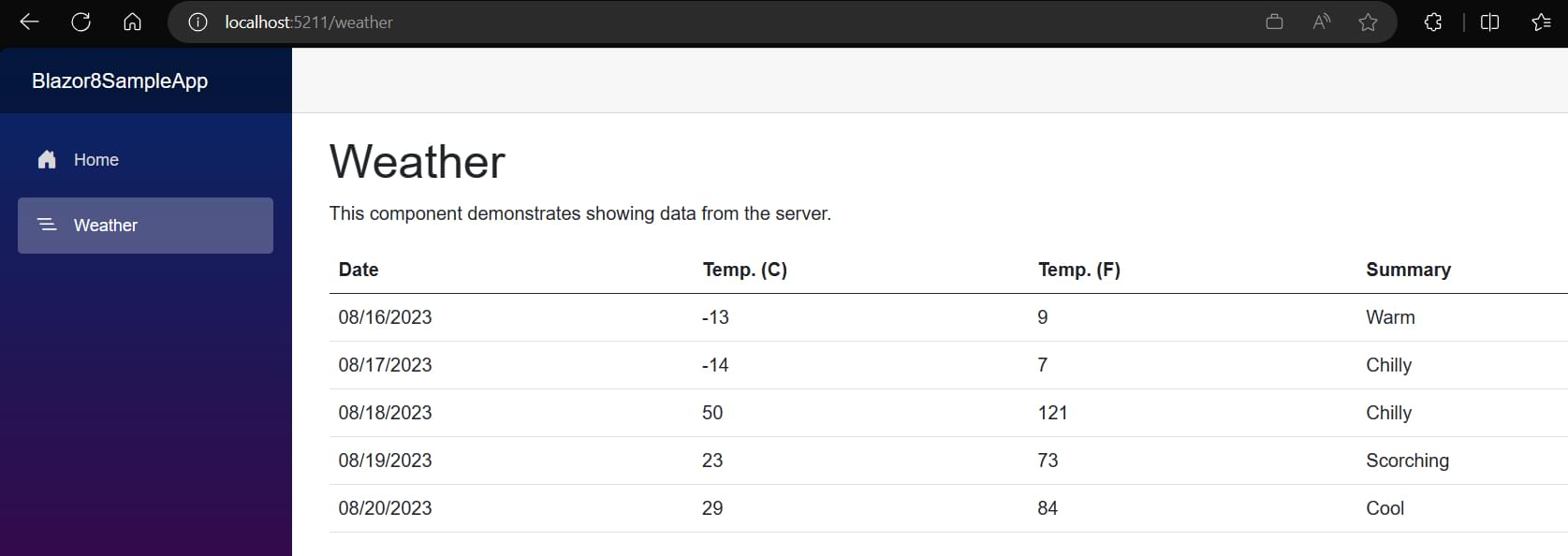
-
From inside VS Code, navigate to the
Program.csfile. The Blazor Net App template is about up for Server-side rendering of Razor elements by default. InProgram.csthe decision toAddRazorComponents()provides the associated providers, after whichMapRazorComponents<App>()discovers the accessible elements and specifies the foundation element for the app. -
While you chosen the Climate menu choice, the web page may have briefly confirmed Loading, after which it rendered the climate information in a desk. That is an instance of the Stream Rendering function as mentioned earlier.
-
From inside VS Code, navigate to the
/Pages/Climate.razorweb page. Open the code view.Discover line 2:
@attribute [StreamRendering(true)]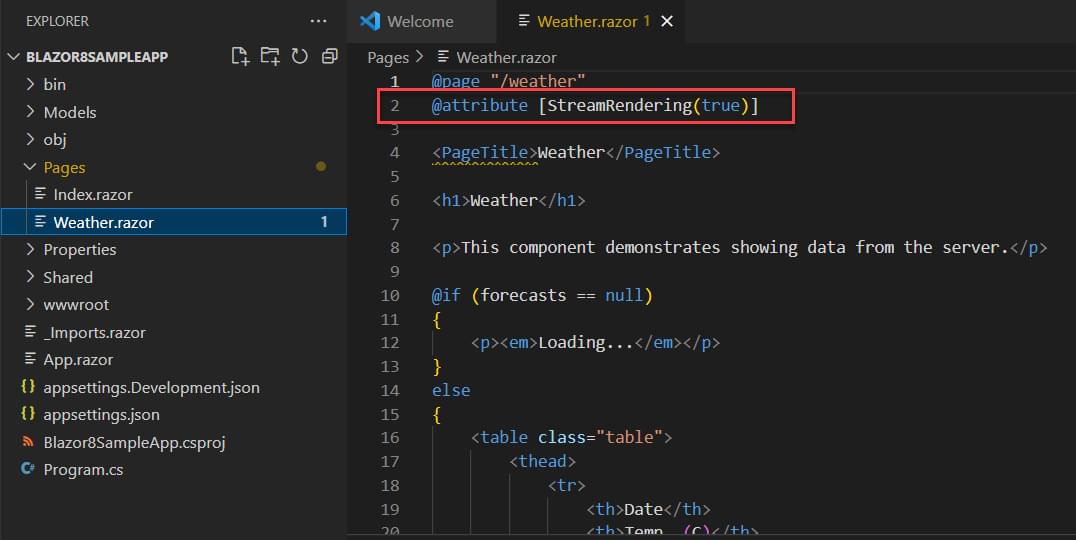
This enables for the brand new Blazor Stream Rendering function to work.
-
Cease the operating app by closing the browser, or press Ctrl + C from the terminal window. Replace the earlier code part to this:
@attribute [StreamRendering(false)] -
Save the modifications, and run the app once more by initiating
dotnet run . Blazor8SampleApp.csprojfrom the terminal window. -
Browse to the operating software once more by clicking on the
http://localhost:5211URL, and click on the Climate app. Discover how, this time, there’s no Loading… message proven, but it surely takes a number of seconds for the web page to render and present the precise climate desk.
Abstract
The journey of net software growth has advanced from static HTML to the dynamic and interactive experiences we take pleasure in (and count on!) right this moment. With .NET Blazor, Microsoft has taken a major step in providing builders a strong framework that unifies client-side and server-side growth paradigms.
As we eagerly anticipate the discharge of .NET Blazor 8, we are able to sit up for enhanced efficiency, improved tooling, and options corresponding to server-side in addition to stream rendering, which can proceed to raise the online growth panorama. Whether or not you’re a seasoned .NET developer or a newcomer to the ecosystem, .NET Blazor opens doorways to constructing next-generation net functions with the ability of C# and .NET.


